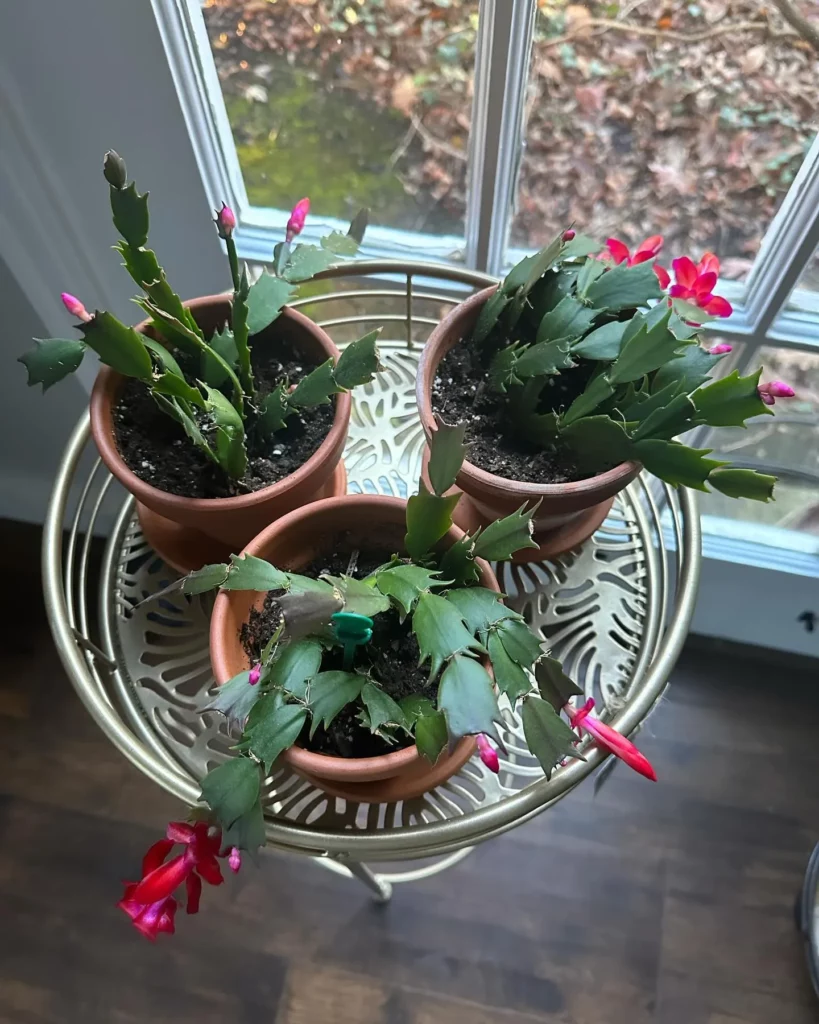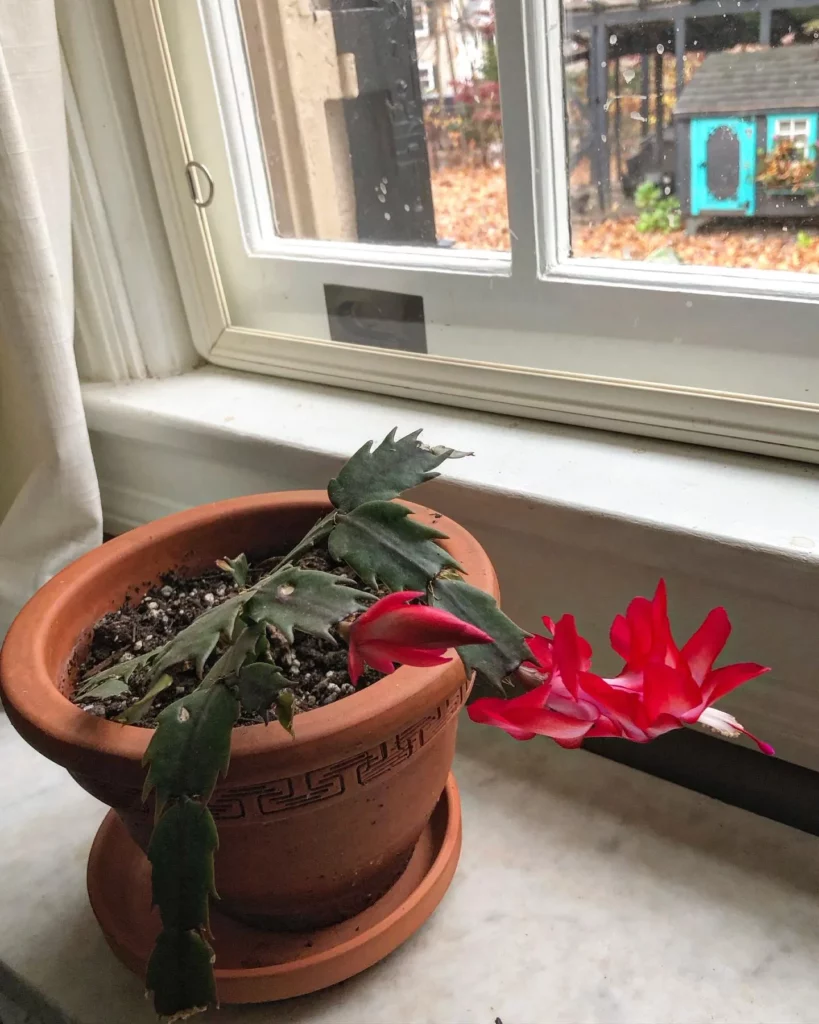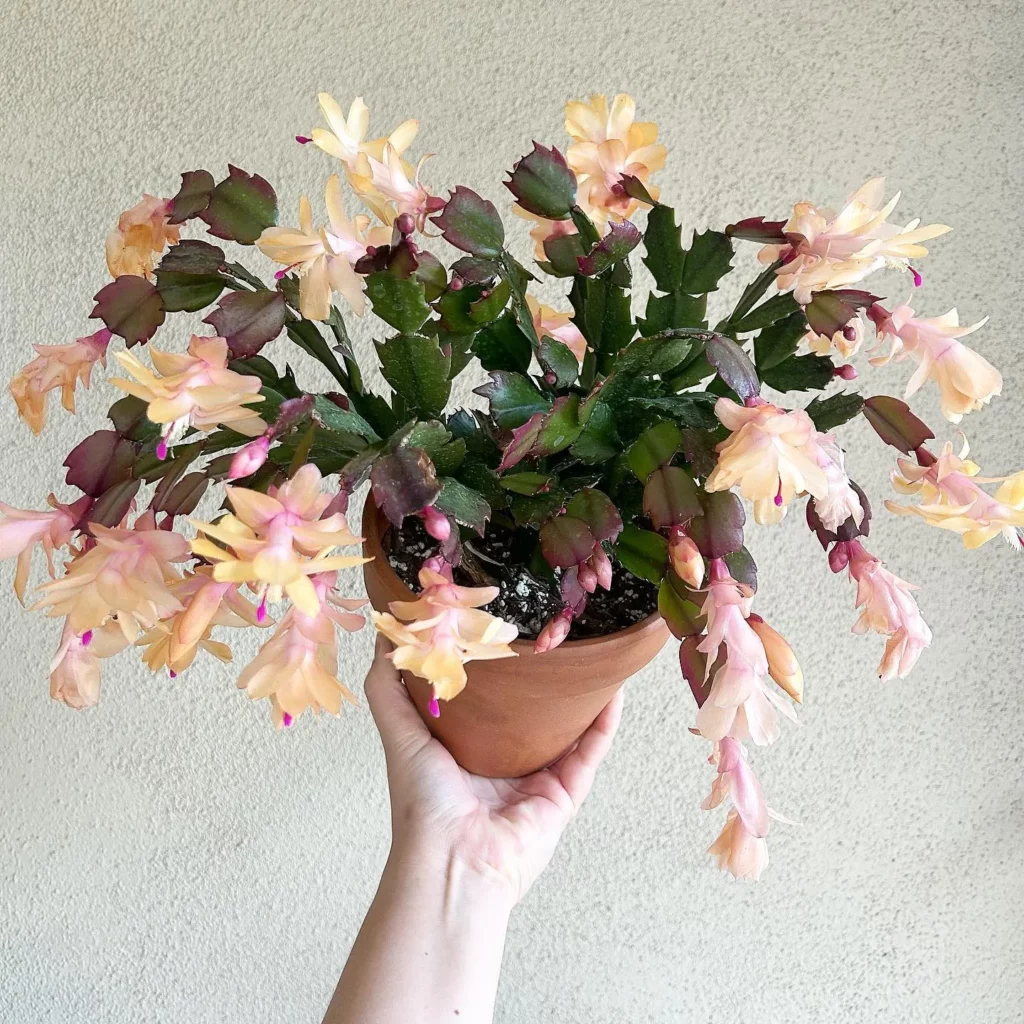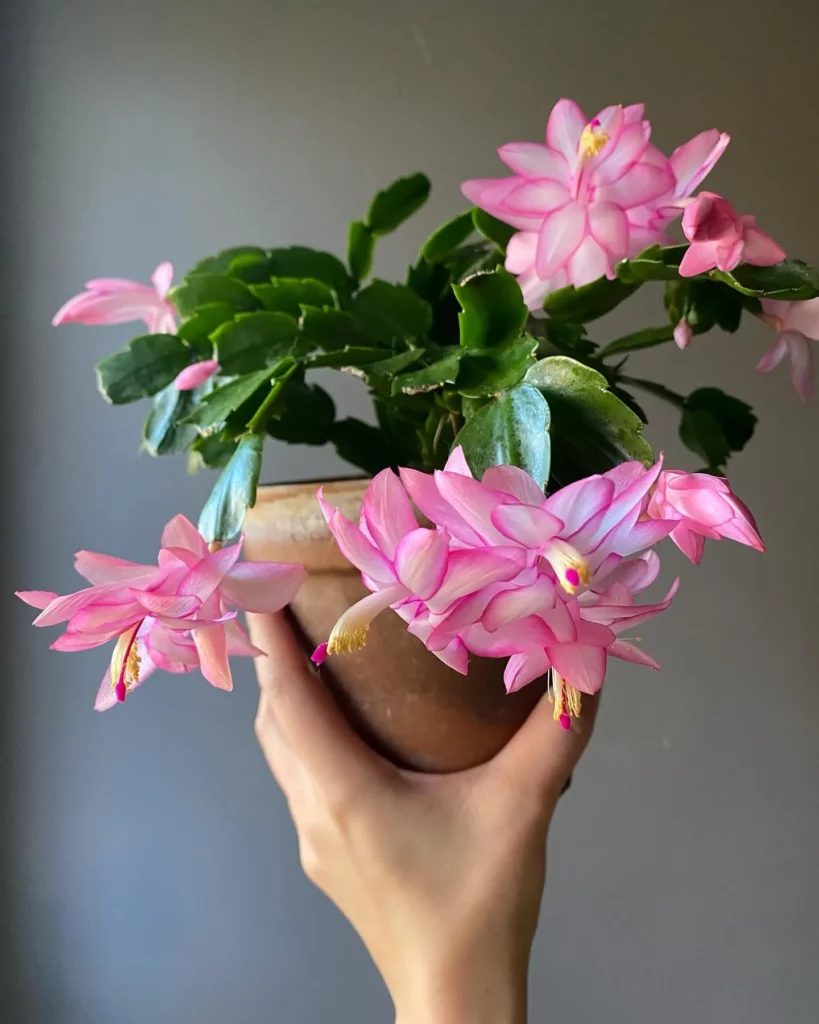To propagate a Christmas cactus, snip off a segment of the stem containing 2-3 segments, let it dry for a few hours to form a callus, then plant it shallowly in moist, well-draining soil and keep it in indirect light until it roots.
This guide covers all you need to know about propagating Christmas cacti, from stem and leaf cuttings to water and soil methods, including division and grafting. It offers tips for care, troubleshooting, and creative propagation ideas, aimed at helping enthusiasts expand their collections or share these plants with others.
Understanding Christmas Cactus Anatomy

Before diving into propagation methods, it’s crucial to understand the basic anatomy of a Christmas cactus. By familiarizing yourself with the different parts of the plant, such as the stem segments, leaves, and roots, you’ll gain a better understanding of how propagation works.
The stem segments of a Christmas cactus are the main components of the plant. These segments are flat, green, and often have serrated edges. They are responsible for storing water and nutrients, making them vital for the plant’s survival.
The leaves of a Christmas cactus play a crucial role in its overall health. These flattened, succulent-like structures not only provide the plant with an attractive appearance but also serve as sites for photosynthesis.
The leaves are comprised of specialized cells that convert light into energy, helping the plant to grow and thrive.
The roots of a Christmas cactus are essential for water and nutrient uptake. These fibrous structures extend from the base of the stem segments and penetrate the soil.
They absorb water and necessary minerals, ensuring the plant receives the nutrients it needs to grow and develop.
To visualize the different parts of a Christmas cactus, take a look at the image below:
Propagating Christmas Cacti from Stem Cuttings

One of the most popular and effective methods of propagating Christmas cacti is through stem cuttings. This method allows you to create new plants from healthy stems, ensuring genetic similarity to the parent plant.
Follow these step-by-step instructions to successfully propagate your Christmas cacti.
Step 1: Selecting and Preparing the Stem Cuttings
- Choose a healthy stem on the parent plant that is approximately 2-4 segments long. Look for stems that are green and not too woody.
- Using clean, sharp pruning shears or a knife, make a clean cut just above a segment joint. This will ensure that the cutting has a growth point for new roots.
- Remove any lower leaves from the stem, leaving only 2-3 segments at the top.
No products found.
Step 2: Preparing the Cuttings for Propagation
- Allow the cuttings to dry for 1-2 days. This will help prevent rotting during the rooting process.
- Once the cut ends are dry, dip the bottom 1-2 segments of each cutting into a rooting hormone powder. This will stimulate root growth and increase the success rate of propagation.
Step 3: Creating the Optimal Conditions for Root Development
To promote root development, it’s important to provide the right conditions for your stem cuttings. Follow these guidelines:
- Fill a small pot or container with well-draining soil or a mixture of peat moss and perlite.
- Make a small hole in the soil using a dibber or your finger.
- Insert the bottom end of the cutting into the hole and gently press the soil around the base to provide stability.
- Water the cutting thoroughly and allow excess water to drain.
- Place the pot in a warm, bright location, but away from direct sunlight.
- Maintain a consistent moisture level in the soil, ensuring it doesn’t become waterlogged.
Growing Christmas Cacti from Leaf Cuttings

Looking to propagate your Christmas cactus? Leaf cuttings offer an effective method for expanding your collection. By selecting and preparing healthy leaves, you can encourage new growth and ensure successful propagation.
Follow these techniques and best practices to grow vibrant Christmas cacti from leaf cuttings.
Selecting Healthy Leaves
When choosing leaves for propagation, opt for mature, healthy ones on your Christmas cactus. Look for leaves that are plump, firm, and free from any signs of damage or disease.
Additionally, ensure the leaves have at least two individual segments, as these segments will develop into new plants.
Preparing Leaf Cuttings
To prepare the leaf cuttings, gently twist or snap off a healthy leaf segment from the main plant. Be careful not to damage the remaining portion of the leaf. You can propagate multiple leaf cuttings at once to increase your chances of success.
Rooting the Cuttings
Once you have your leaf cuttings, it’s time to root them for growth. Prepare a well-draining propagating mix by combining equal parts perlite and potting soil. Moisten the mix and fill a small pot or container with it.
Gently place the cut end of the leaf cutting into the propagating mix, ensuring the segments are partially buried. Mist the cutting and the surrounding soil lightly with water to provide moisture for root development.
Care and Maintenance
During the rooting process, it’s important to keep the soil damp but not overly wet. Too much moisture can lead to rotting or fungal diseases. Place the pot in a warm, well-lit area, but avoid direct sunlight as it can scorch the leaves.
Over time, the leaf cutting will develop roots and small plantlets. This process can take several weeks to a few months, so be patient.
Once the plantlets have grown large enough, you can gently separate them from the leaf and transplant them into individual pots.
Water Propagation for Christmas Cacti

If you’re looking for an easy and straightforward method for propagating your Christmas cacti, water propagation is the way to go. This method allows you to root your cuttings in water, providing them with the moisture and nutrients they need to develop strong roots and grow into healthy plants.
Here are the steps to successfully propagate Christmas cacti in water:
- Start by selecting healthy stem cuttings from the parent plant. Choose segments that are around 3-4 segments long, ensuring that each segment has at least one or two leaf segments.
- Once you have your cuttings, remove a few of the lower leaf segments to expose the nodes.
- Fill a clean glass or jar with filtered water, ensuring that the water level is just below the nodes of the cuttings.
- Place the cuttings in the water, making sure that the nodes are submerged but the leaves are not touching the water.
- Find a bright location, but avoid direct sunlight as it can heat up the water and harm the cuttings.
- Change the water every week or whenever it becomes cloudy to prevent the growth of bacteria or algae.
- After a few weeks, you’ll start to see roots forming from the nodes of the cuttings. Once the roots are at least one inch long, your cuttings are ready to be potted.
- Prepare a well-draining potting mix and gently plant the rooted cuttings, ensuring that the roots are covered but the leaf segments remain above the soil.
- Water the newly potted cuttings thoroughly and place them in a location with indirect sunlight.
Soil Propagation Techniques for Christmas Cacti

If you prefer a more traditional approach to propagating your Christmas cacti, soil propagation is an excellent choice. This method allows you to recreate the natural conditions in which these cacti thrive, resulting in successful rooting and healthy growth.
To begin soil propagation, you’ll need a few essential materials:
- A well-draining pot or container
- High-quality succulent or cactus soil mix
- A sharp, clean knife or scissors for stem cutting
- Rooting hormone (optional)
Start by selecting healthy stem cuttings from your mature Christmas cactus. Make sure the cuttings are at least two to three segments long and have no signs of damage or disease.
Using a clean knife or scissors, carefully remove the cuttings from the main plant.
No products found.
Once you have your cuttings, allow them to callus over for a day or two. This step helps prevent rotting when they are planted in soil. After the cuttings have callused, gently dip the cut ends in rooting hormone if desired.
While not necessary, rooting hormone can help stimulate faster root development.
Prepare your pot or container by filling it with well-draining succulent or cactus soil mix. Make a small hole in the soil with your finger or a pencil and carefully insert the stem cutting into the hole. Gently press the soil around the cutting to secure it in place.
After planting, lightly water the soil to settle it around the cutting. Be cautious not to overwater, as Christmas cacti prefer slightly drier conditions.
Allow the soil to dry out partially between waterings, and be sure to water the plant from the bottom to avoid saturating the stem cutting.
No products found.
Place your potted cutting in a warm, bright location with indirect sunlight. A temperature range of 60-70°F (15-21°C) is ideal for rooting and growth. Avoid placing the cutting in direct sunlight, as it can cause sunburn or scorching.
Now, it’s time for patience and proper care. Provide regular but gentle watering, making sure to let the soil dry out between each watering. Overwatering can lead to root rot and other issues.
Your Christmas cactus cutting will gradually develop roots and begin to grow new segments and leaves. This process can take several weeks to a few months, so be patient and give your cutting time to establish itself.
Propagation by Division

If you have an older Christmas cactus plant that has become overgrown or leggy, division is a great method to rejuvenate it and create new, healthy plants. By carefully dividing the plant into separate segments, you can ensure the health and vitality of each new plant.
To propagate your Christmas cactus through division, follow these simple steps:
- Choose a mature, healthy Christmas cactus plant that you want to divide.
- Gently remove the plant from its pot, being careful not to damage the roots.
- Inspect the plant and look for natural divisions, where the stem segments naturally separate.
- Using a sharp, clean knife or garden shears, carefully cut through the stem segments at the natural division points.
- Make sure each new segment has at least three to four stem segments and a healthy root system.
- Prepare pots with well-draining soil and place each new segment in its own pot.
- Water the newly divided plants thoroughly and place them in a bright, indirect light location.
- Continue to care for the newly propagated plants, providing them with the right amount of water, light, and humidity to aid in their healthy growth.
- Monitor the plants closely, ensuring they develop new growth and establish themselves in their new pots.
Propagating Christmas Cacti with Grafting

Grafting is an advanced propagation technique that offers a unique way to propagate rare or unique varieties of Christmas cacti. By grafting a piece of one Christmas cactus onto the rootstock of another, you can create a plant that combines the desirable traits of both varieties.
The process of grafting involves carefully joining the tissues of two plants so that they grow together and form a single plant. Although it may require some practice and patience, grafting can be a rewarding method for propagating Christmas cacti.
To successfully graft Christmas cacti, follow these steps:
- Start by selecting a healthy, well-established Christmas cactus plant as the rootstock. This plant will provide the root system and support for the grafted scion.
- Next, choose a desirable variety of Christmas cactus to use as the scion. This should be a cutting from a plant with the specific traits you wish to propagate.
- Using a sharp, sterilized knife or razor blade, make a clean diagonal cut at the base of the scion and the corresponding area on the rootstock. The cuts should be made at an angle to facilitate a tight and secure graft union.
- Carefully join the cut surfaces of the scion and rootstock, making sure they fit together snugly. Use grafting clips or rubber bands to hold the two pieces in place.
- After grafting, place the plant in a warm and humid environment to encourage healing and growth. Provide indirect light and maintain consistent moisture levels.
- Over time, the scion and rootstock will fuse, and new growth will emerge from the graft union. Once the plants have fully joined together, you can remove the clips or bands.
Caring for Propagated Christmas Cacti

Once your Christmas cacti cuttings have successfully rooted and grown, they require specific care to thrive. Providing the right care for your propagated plants is essential to ensure their health and longevity.
Watering
Proper watering is crucial for the well-being of your propagated Christmas cacti. Water the plants thoroughly, allowing the water to soak through the soil.
Ensure that the soil is well-draining to prevent waterlogging, which can lead to root rot. Let the top inch of soil dry out before watering again.
Light Requirements
Christmas cacti prefer bright, indirect light. Place your propagated plants near a window that receives filtered sunlight or provide them with artificial grow lights.
Avoid exposing them to direct sunlight, as it can scorch the leaves.
Temperature Considerations
Christmas cacti thrive in temperatures between 60°F and 70°F (15°C and 21°C).
Avoid placing them in excessively hot or cold locations, as extreme temperatures can stress the plants. Keep them away from drafts, air conditioning vents, and heaters.
Fertilizing
Fertilize your propagated Christmas cacti during the growing season, which usually occurs from spring to early fall. Use a balanced houseplant fertilizer and follow the recommended dosage instructions.
Over-fertilization can lead to burning the roots, so it’s important to avoid excessive feeding.
Pruning
Regular pruning helps maintain the shape and size of your propagated Christmas cacti. Trim back any leggy growth or damaged stems to encourage bushier and healthier plants.
Use clean, sharp pruning shears to prevent the spread of diseases.
Pest Control
Keep an eye out for common pests like mealybugs, scale insects, and spider mites. If you notice any signs of infestation, such as webbing, white cotton-like clusters, or sticky residue on the leaves, take immediate action.
Use organic pest control methods or consult with your local gardening center for appropriate treatments.
Common Issues in Christmas Cactus Propagation

While propagating Christmas cacti is generally straightforward, you may encounter some common issues along the way. Here are a few troubleshooting tips to help you address these problems and ensure successful propagation:
- Root Rot: One of the most common problems in propagation is root rot, which occurs when the roots are exposed to excess moisture. To prevent this, make sure you use well-draining soil and avoid overwatering. Additionally, avoid placing your cuttings in standing water.
- Overwatering: Overwatering can cause root rot and lead to other issues such as stem rot or fungal diseases. Remember to water your cuttings sparingly and allow the soil to dry out slightly between waterings. It’s better to underwater than to overwater.
- Pests: Keep an eye out for common pests like mealybugs and spider mites, which can infest your Christmas cactus cuttings. If you notice any signs of pest infestation, such as visible insects or damage to the leaves, treat the affected plants with horticultural soap or insecticidal spray.
- Improper Light Exposure: The amount of light your Christmas cactus cuttings receive can significantly impact their growth. Avoid placing them in direct sunlight, as this can lead to sunburn. Instead, provide bright, indirect light for a few hours a day.
- Temperature Fluctuations: Christmas cacti prefer consistent temperatures, so avoid exposing your cuttings to extreme heat or cold. Keep them in a stable environment with temperatures ranging between 60°F to 70°F (15°C to 21°C).
Propagating Christmas Cacti: Tips and Best Practices

To ensure the greatest chance of success with your Christmas cactus propagation, it’s helpful to know some tips and best practices. Here are expert recommendations to help you along the way:
- Timing is key: Propagate your Christmas cacti during their active growth period, which is typically in the spring or summer. This is when the plant has the highest chance of successful rooting and growth.
- Choose the right tools: Use clean and sharp gardening shears or a clean knife for taking cuttings. This helps prevent unnecessary damage to the parent plant and ensures clean cuts that promote healthy rooting.
- Create the ideal environment: Provide your Christmas cactus cuttings with the optimal conditions for successful propagation. Opt for well-draining soil or water, maintain a temperature range of 70-80°F (21-27°C), and provide bright but indirect light.
- Patience is key: Propagation takes time, so it’s important to be patient during the rooting process. Avoid the temptation to disturb or check the progress of the cuttings too frequently, as this can disrupt their development.
- Monitor moisture levels: Strike a balance between overwatering and underwatering your cuttings. Keep the soil or water consistently moist but not soaking wet. Too much water can lead to root rot, while too little can hinder root development.
- Protect from pests: Keep a close eye on your Christmas cactus cuttings for any signs of pests, such as mealybugs or spider mites. Treat infestations promptly using organic pest control methods to avoid damage to your propagated plants.
- Gradual acclimation: Once your Christmas cactus cuttings have rooted and started growing, gradually acclimate them to their final growing conditions. This helps them adjust to changes in temperature, light, and humidity more successfully.
- Continued care: Remember that proper care is essential for the long-term health of your propagated Christmas cacti. Provide regular watering, appropriate lighting, and occasional fertilizer to keep your plants thriving.
Creative Ideas for Propagating Christmas Cacti
Are you ready to take your Christmas cactus propagation skills to the next level? In this section, we’ll explore some unique and creative ideas that go beyond the traditional methods.
These innovative techniques will help you expand your propagation horizons and have fun experimenting with different approaches.
One creative method is using specialized rooting hormones. These hormones help stimulate root growth and increase the chances of successful propagation.
Simply dip the cut ends of your Christmas cactus cuttings in the rooting hormone before planting them, and watch as they develop strong roots and thrive.
Another exciting idea is to experiment with innovative containers for propagation. Instead of traditional pots, try using glass jars or clear plastic containers.
Not only do these provide a unique visual appeal, but they also allow you to observe the root development and overall progress of your propagated plants.
For a truly creative twist, consider air layering your Christmas cacti. Air layering involves creating a rooting environment directly on the plant without removing a cutting.
By placing a rooting medium around a section of the stem and covering it with a plastic wrap, you can encourage roots to form. Once the roots are well-established, you can separate the new plant from the original one and enjoy a beautiful, rooted cutting.
FAQ
Q: What are the different parts of a Christmas cactus?
A: The Christmas cactus consists of stem segments, leaves, and roots.
Q: How do I propagate Christmas cacti from stem cuttings?
A: To propagate Christmas cacti from stem cuttings, you’ll need to carefully take cuttings, prepare them for propagation, and provide optimal conditions for root development.
Q: Can I propagate Christmas cacti using leaf cuttings?
A: Yes, you can propagate Christmas cacti by using leaf cuttings. You’ll need to select and prepare healthy leaves and ensure proper rooting to support successful growth.
Q: Is water propagation suitable for propagating Christmas cacti?
A: Yes, water propagation is a viable method for propagating Christmas cacti. You’ll need to follow specific steps and provide proper care during the rooting process.
Q: How do I propagate Christmas cacti in soil?
A: To propagate Christmas cacti in soil, you’ll need to adhere to specific soil requirements and provide the necessary care to ensure successful rooting and growth.
Q: Can I propagate Christmas cacti by division?
A: Yes, division is a method that can help rejuvenate older, overgrown Christmas cactus plants. You’ll need to carefully divide the plant into separate segments to ensure the health of each new plant.
Q: Can I use grafting to propagate Christmas cacti?
A: Yes, grafting is a more advanced propagation technique that can be used to propagate rare or unique varieties of Christmas cacti. It involves the process of joining plant tissues to create a new plant.
Q: How do I care for propagated Christmas cacti?
A: Proper care for propagated Christmas cacti includes considerations for watering, light requirements, temperature, and other important aspects of plant care.
Q: What are common issues in Christmas cactus propagation?
A: Common issues in Christmas cactus propagation include problems like root rot, overwatering, and pests. It’s important to be aware of these issues and know how to address them.
Q: What are some tips and best practices for propagating Christmas cacti?
A: Some tips and best practices for propagating Christmas cacti include timing, choosing the right tools, and creating the ideal environment for propagation.
Q: Are there any creative ideas for propagating Christmas cacti?
A: Yes, there are creative ideas for propagating Christmas cacti that go beyond traditional methods. These ideas involve using specialized rooting hormones and experimenting with innovative containers.





